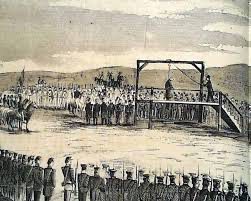In the wake of John Brown’s 1859 raid on Harpers Ferry, Alexandria’s Colonel Charles Edward Stuart was called to lead the 175th Virginia Militia, deployed to Charlestown, Virginia (now West Virginia), to guard Brown during his trial and execution. The famed abolitionist’s attempt to incite a slave uprising shocked the nation—and Virginia took no chances. Militia regiments, including Stuart’s, surrounded the courthouse and gallows to prevent any rescue attempts.
Stuart’s involvement placed Alexandria at the heart of a national crisis just months before the Civil War erupted. When Union troops seized Alexandria in May 1861, Stuart—aligned with the Confederacy—left the city and did not return until after the war. He resumed his legal career and served as attorney for the Corporation of Alexandria in his final years.
He died on Christmas Day, 1874, and was buried in the Episcopal Cemetery in Alexandria. Among the pallbearers at his funeral was Francis L. Smith, Jr., a prominent Alexandrian and fellow Confederate veteran, who would later be buried in the nearby Presbyterian Cemetery. Together, their lives reflected a city divided by war—but bound by legacy.
